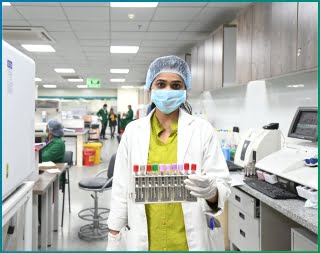
The C/S vaginal swab is a test where a sample of vaginal discharge or secretions is taken using a sterile swab.

A C/S vaginal swab, commonly referred to as a culturing and sensitivity vaginal swab, is a diagnostic test used to identify infections in the vaginal area and determine which antibiotics or treatments will be most effective. It is an essential tool in gynecology and obstetrics for diagnosing various vaginal infections and ensuring appropriate treatment. This procedure involves collecting a sample of discharge or fluids from the vagina to analyze the presence of bacteria, fungi, or other pathogens that could be causing infection.
1] Diagnosing Vaginal Infections: The swab helps identify common vaginal infections, such as bacterial vaginosis (BV), yeast infections (candidiasis), and sexually transmitted infections (STIs) like gonorrhea, chlamydia, and trichomoniasis.
2] Identifying Antibiotic Resistance: The sensitivity part of the test identifies which antibiotics are most effective against the detected pathogen. This is particularly useful in cases where an infection is resistant to certain antibiotics or treatments.
3] Pre-surgical Screening: In some cases, a vaginal swab may be taken before a surgical procedure, such as a cesarean section, to screen for any potential infections that could affect the surgery or recovery.
4] Monitoring Chronic or Recurrent Infections: Women who experience recurrent vaginal infections may undergo regular C/S vaginal swabs to determine the cause and appropriate treatment plan.
5] Monitoring Pregnancy-Related Infections: In pregnant women, infections like group B Streptococcus (GBS) are common, and this test can be used to ensure the infection is treated before delivery to prevent complications for the baby.
The process of performing a C/S vaginal swab is simple and minimally invasive:
1] Preparation: The patient is asked to lie on an examination table, usually in a position similar to a pelvic exam, with their legs in stirrups.
2] Collection: A sterile swab is gently inserted into the vagina to collect a sample of vaginal discharge or secretions. The sample is then placed in a sterile container or culture tube for transport to the laboratory.
3] Lab Analysis: Once at the lab, the sample is cultured to allow any bacteria, fungi, or parasites to grow. Sensitivity testing is then performed to identify which antibiotics or antifungal agents will be most effective in treating the infection.
4] Results: Results are typically available within 2 to 5 days, depending on the lab's processing time and the complexity of the infection. The healthcare provider will discuss the results and recommend treatment based on the findings.
1] Accurate Diagnosis: The C/S vaginal swab provides a precise identification of the infection-causing organism, leading to better-targeted treatments.
2] Guided Treatment: The sensitivity test helps healthcare providers select the most effective antibiotics or antifungal medications, reducing the risk of ineffective treatment or resistance.
3] Prevention of Complications: By detecting infections like group B streptococcus or STIs, the test can help prevent complications during pregnancy, delivery, or in cases of chronic infections.
4] Pre-surgical Safety: For women undergoing surgery, a C/S vaginal swab helps reduce the risk of postoperative infections by identifying and treating any existing infections beforehand.
Choosing Diagnopein for your C/S vaginal swab test ensures that you receive accurate, reliable, and timely diagnostic results in a compassionate and professional environment. At Diagnopein, we prioritize patient comfort and confidentiality while utilizing state-of-the-art laboratory facilities and experienced medical staff. Our advanced testing methods provide precise identification of infections, including bacterial vaginosis, yeast infections, and sexually transmitted diseases, along with detailed sensitivity analysis to guide effective treatment. With a commitment to excellence and quick turnaround times, Diagnopein ensures that your healthcare journey is as seamless and stress-free as possible, allowing for prompt diagnosis and personalized care. Whether you're seeking routine screening, treatment guidance, or pre-surgical assessments, Diagnopein is dedicated to supporting your health with the highest standards of quality and care.
1. Culture Method
2. Sample
3. Colony Count
4. Organism(s) Isolated
5. Culture Report: Culture yields growth of
6. Culture isolated after 7 days :
7. Culture isolated after 14 days:
8. Culture isolated after 21 days:
9. Ampicillin
10. Amikacin
11. Amoxicillin clavulanate
12. cefoperazon+sulbactam
13. Cefuroxime
14. Cefepime
15. Cefotaxime
16. Ciprofloxacin
17. Ertapenem
18. Gentamicin
19. Imipenem
20. Meropenem
21. Norfloxacin
22. Nitrofurantoin
23. Piperacillin-tazobactam
24. Trimethoprim-Sulfamethoxazole (Cotrimoxazole)
Yes, the test is safe and minimally invasive with very few risks or side effects.
It can detect bacterial vaginosis, yeast infections (candidiasis), STIs like chlamydia, gonorrhea, and trichomoniasis, as well as group B streptococcus and other infections.
Your healthcare provider will recommend appropriate treatment based on the type of infection and the antibiotics or antifungals the pathogen is sensitive to.
It is recommended to avoid douching, using vaginal creams, or having sex 24–48 hours before the test to ensure accurate results.